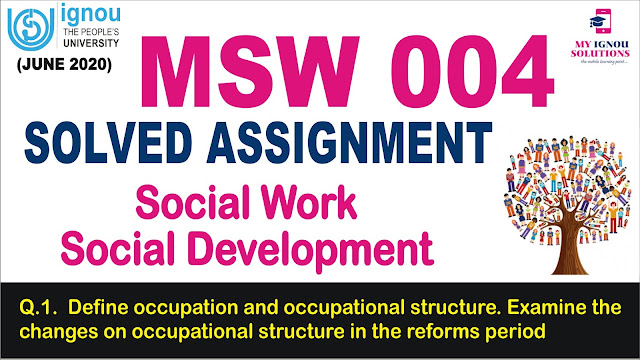Define occupation and occupational structure. Examine the changes on occupational structure in the reforms period
Q.1. Define occupation and occupational structure. Examine the changes on occupational structure in the reforms period.
You have already read that liberalization of trade and
commerce and opening up of the economy for world market is an essential feature
of globalization. It has deep impact on the internal structure of the economy,
especially on work, employment and occupations. As a result of this process,
old occupations undergo change and new occupations emerge. After
liberalization, new occupations are emerging in the fields of information
technology, business process outsourcing, sales and marketing, research etc.
opening up newer opportunities for the younger age group.
Definition and Meaning Occupation may be
defined as the economic role played by a person outside of household/domestic
activity which accrues the person an income and a general social status. Simple
societies have very few occupations. With progress of a society from simple to
complex, and with increasing division of labour, new tasks emerge, so do new
and more occupations. Hence, the occupational structure of a complex society is
far developed and broad ranging than that of a simple society.
It is determined by a number of factors such as the geography
of a place, level of technological development and productive forces, division
of labour and specialisation, levels of per capita income, structure of the
economy and so on. Geography and ecology of a place put constraints over the
choice of work by the availability of resources. For example, a coastal area
rich in fishing resources will have fishing as the predominant occupation. Even
in developed industrialised countries like Norway, Sweden and Canada, forestry
(a primary activity) provides sizeable employment as does fishing in Japan. As
technology advances, productive forces are developed and there is
diversification in the occupational structure. It is a historical experience
that when the per capita income of an economy is low, sizeable labour force is
employed in agriculture, animal husbandry, fishing and forestry. As the per
capita income rises, demand for manufactured goods rises, thereby expanding the
output in manufacturing industries in the secondary sector. Thus a labour shift
occurs from agriculture and allied activities to industrial occupations.
Occupational Structures
An example of occupational structure is as following:
professional, technical, managerial, clerical, sales, skilled, semi-skilled,
and unskilled. These categories may be further sub-divided into a number of
particular occupations. The International Standard Classification of
Occupations (ISCO) of International Labour Organization draws a pyramid-like
hierarchal structure consisting of 10 major groups, subdivided into 28
sub-major groups, 116 minor groups and 390 unit groups. Industrial structure
may classify according to broad areas like primary, secondary and tertiary or
further sub-divide them into agriculture, manufacturing transportation,
communication, government trade, and other services. In India, the Census
classifies occupations using categories such as ‘primary sector’ sub-divided
into cultivators, agricultural labourers, livestock, forestry and fishing,
mining and quarrying; ‘secondary sector’ sub-divided into household and other
industry, and construction; ‘Tertiary sector’ sub-divided into trade and
commerce, transport, storage and communications, and other services.
Occupational mobility is defined as the change of job or
occupation by a person after acquisition of new skills. It can be
intra-generational when a person changes occupation within his working life, or intergenerational when a person
pursues an occupation different from one’s father. It can be upward when the
new occupation is of higher status and reward, or downward when it is the
opposite. Societies can be classified as ‘status society’ and ‘occupational
society’. A status society is one in which one’s social status (usually
ascribed by birth, gender, age) determines what occupation one would pursue.
Caste societies in India were status societies since occupations were fixed on
the basis of caste. Status societies have little or no scope for occupational
mobility. In contrast, an occupational society has high level of division of
labour, a highly developed cash economy and relatively free labour markets.
One’s occupational status is distinct from one’s other statuses and there is
great degree of mobility.
If You Want Full PDF
Whatsapp : 8130208920
Per Subject PDF 49/- Only






Post a Comment